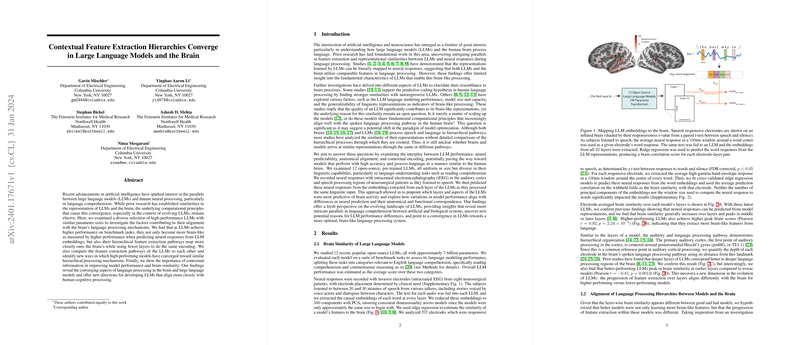The paper "Contextual Feature Extraction Hierarchies Converge in LLMs and the Brain" investigates the parallels between LLMs and the human brain in terms of language comprehension. The paper builds on prior research that has established certain similarities between LLMs and the brain, aiming to uncover the computational principles that drive these convergences, especially as LLMs evolve. Here are the key insights and findings from the paper:
- Performance and Brain-Likeness: The research highlights that as LLMs improve their performance on benchmark tasks, they increasingly resemble brain processes. This resemblance is quantified by the ability of the models to predict neural responses. High-performing LLMs showed better prediction accuracy of neural responses from their embeddings.
- Hierarchical Feature Extraction: An intriguing finding is the mapping of hierarchical feature extraction pathways in LLMs onto those in the brain. Specifically, the paper found that despite using fewer layers, LLMs could achieve similar encoding levels to the brain. This suggests that high-performing LLMs have optimized their processes in ways that mimic the brain's language processing mechanisms more closely.
- Model Comparisons: The researchers compared a variety of high-performance LLMs with similar parameter sizes. They discovered that as these models advanced in their capabilities, they converged toward similar hierarchical processing mechanisms. This convergence implies that there may be an optimal way to structure language processing hierarchically that both brains and high-performing LLMs are independently discovering.
- Importance of Context: The paper underscores the critical role of contextual information in enhancing both the performance of the models and their similarity to brain processes. Effective incorporation of contextual cues appears to be a common factor in the success of both LLMs and human neural processing in language comprehension.
- Future Directions: Based on their findings, the authors suggest new avenues for developing LLMs that align more closely with human cognitive processes. This could potentially lead to advancements in creating AI that processes language in a way that is more intuitive and human-like.
In conclusion, the paper provides compelling evidence that as LLMs evolve, their language processing mechanisms increasingly resemble those of the brain. This convergence occurs not only in terms of performance but also in the hierarchical feature extraction pathways, suggesting a fundamental similarity in how both systems handle language. The emphasis on contextual information offers a promising direction for future research and development in creating ever more sophisticated and brain-like LLMs.
